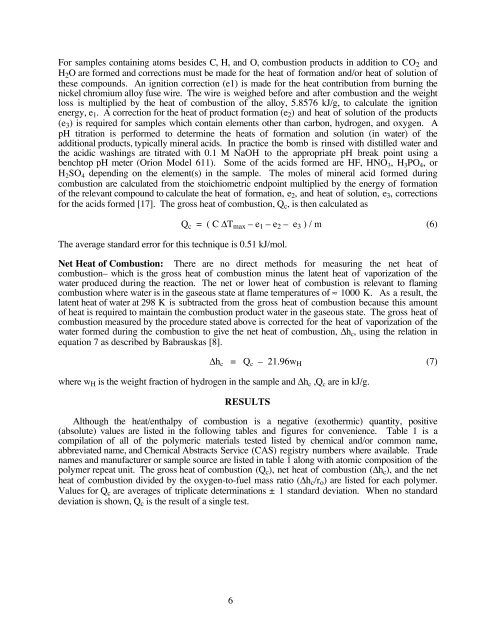HEATS OF COMBUSTION OF HIGH TEMPERATURE POLYMERS
HEATS OF COMBUSTION OF HIGH TEMPERATURE POLYMERS
HEATS OF COMBUSTION OF HIGH TEMPERATURE POLYMERS
Create successful ePaper yourself
Turn your PDF publications into a flip-book with our unique Google optimized e-Paper software.
For samples containing atoms besides C, H, and O, combustion products in addition to CO2 and<br />
H2O are formed and corrections must be made for the heat of formation and/or heat of solution of<br />
these compounds. An ignition correction (e1) is made for the heat contribution from burning the<br />
nickel chromium alloy fuse wire. The wire is weighed before and after combustion and the weight<br />
loss is multiplied by the heat of combustion of the alloy, 5.8576 kJ/g, to calculate the ignition<br />
energy, e1. A correction for the heat of product formation (e2) and heat of solution of the products<br />
(e3) is required for samples which contain elements other than carbon, hydrogen, and oxygen. A<br />
pH titration is performed to determine the heats of formation and solution (in water) of the<br />
additional products, typically mineral acids. In practice the bomb is rinsed with distilled water and<br />
the acidic washings are titrated with 0.1 M NaOH to the appropriate pH break point using a<br />
benchtop pH meter (Orion Model 611). Some of the acids formed are HF, HNO 3, H 3PO 4, or<br />
H 2SO 4 depending on the element(s) in the sample. The moles of mineral acid formed during<br />
combustion are calculated from the stoichiometric endpoint multiplied by the energy of formation<br />
of the relevant compound to calculate the heat of formation, e2, and heat of solution, e3, corrections<br />
for the acids formed [17]. The gross heat of combustion, Qc, is then calculated as<br />
The average standard error for this technique is 0.51 kJ/mol.<br />
Qc = ( C ∆Tmax – e1 – e2 – e3 ) / m (6)<br />
Net Heat of Combustion: There are no direct methods for measuring the net heat of<br />
combustion– which is the gross heat of combustion minus the latent heat of vaporization of the<br />
water produced during the reaction. The net or lower heat of combustion is relevant to flaming<br />
combustion where water is in the gaseous state at flame temperatures of ≈ 1000 K. As a result, the<br />
latent heat of water at 298 K is subtracted from the gross heat of combustion because this amount<br />
of heat is required to maintain the combustion product water in the gaseous state. The gross heat of<br />
combustion measured by the procedure stated above is corrected for the heat of vaporization of the<br />
water formed during the combustion to give the net heat of combustion, ∆h c, using the relation in<br />
equation 7 as described by Babrauskas [8].<br />
∆h c = Q c – 21.96wH<br />
where wH is the weight fraction of hydrogen in the sample and ∆h c ,Q c are in kJ/g.<br />
RESULTS<br />
Although the heat/enthalpy of combustion is a negative (exothermic) quantity, positive<br />
(absolute) values are listed in the following tables and figures for convenience. Table 1 is a<br />
compilation of all of the polymeric materials tested listed by chemical and/or common name,<br />
abbreviated name, and Chemical Abstracts Service (CAS) registry numbers where available. Trade<br />
names and manufacturer or sample source are listed in table 1 along with atomic composition of the<br />
polymer repeat unit. The gross heat of combustion (Qc), net heat of combustion (∆hc), and the net<br />
heat of combustion divided by the oxygen-to-fuel mass ratio (∆hc/ro) are listed for each polymer.<br />
Values for Qc are averages of triplicate determinations ± 1 standard deviation. When no standard<br />
deviation is shown, Qc is the result of a single test.<br />
6<br />
(7)
















